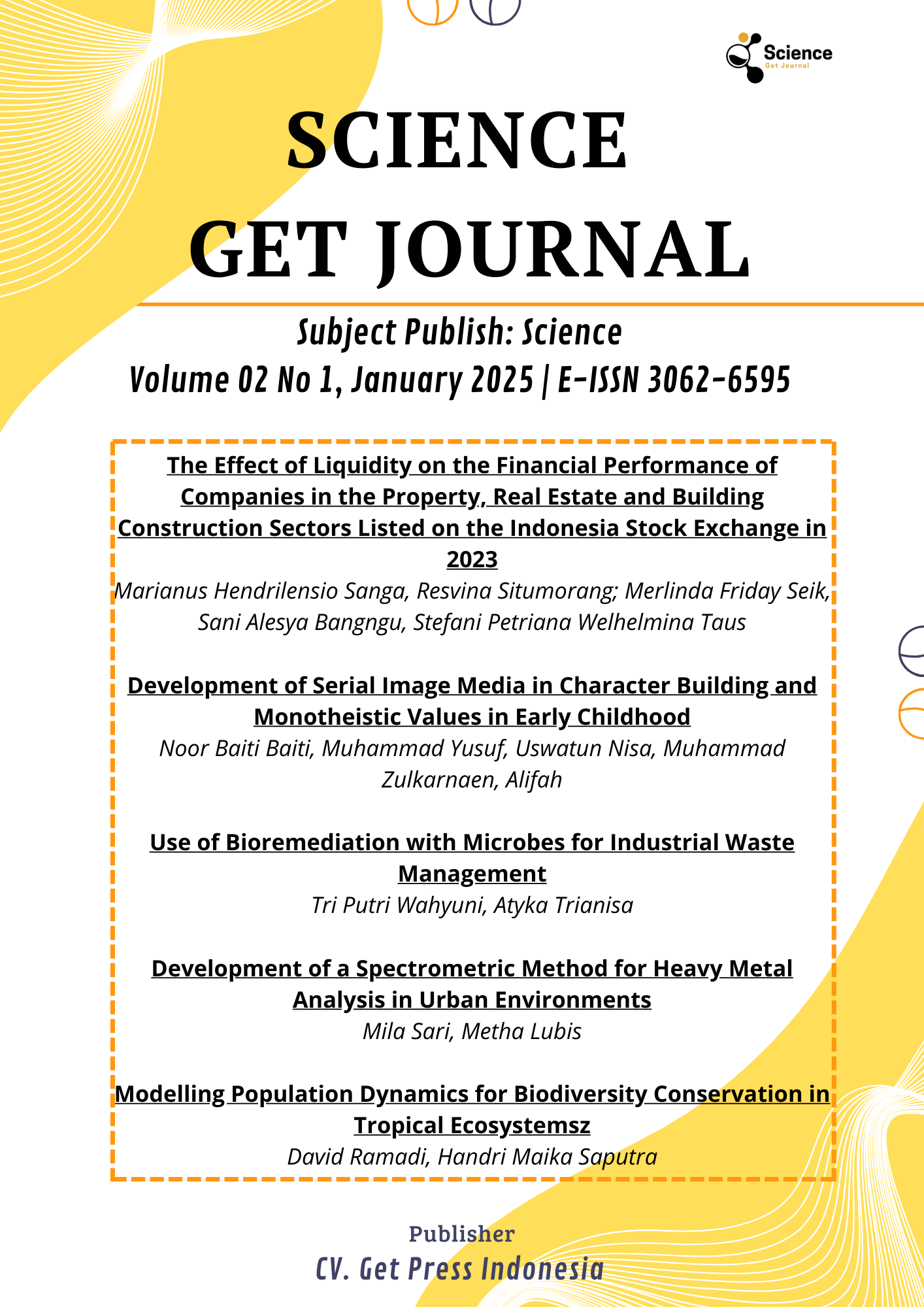Use of Bioremediation with Microbes for Industrial Waste Management
DOI:
https://doi.org/10.69855/science.v2i1.107Keywords:
Bioremediation, Industrial Waste Management, Soil Pollution, Medical WasteAbstract
Rapid industrial growth has significantly contributed to environmental pollution, particularly through hazardous waste disposal. Industrial waste, including heavy metals and toxic organic compounds, poses a major challenge for sustainable environmental management. Improper management of this waste can lead to contamination of water, soil, and air, threatening human health and ecosystems (Bagaskara, 2023; Supraptini, 2002). This study investigates the potential of bioremediation using microbes for industrial waste management and identifies factors influencing its effectiveness. Conducted as an experimental laboratory study, the research tests various microorganisms known for their bioremediation capabilities, such as Pseudomonas, Bacillus, and Aspergillus.Analysis of contaminated soil revealed lead (Pb) levels at 63.1 mg/kg, exceeding the livestock toxic limit of 10–30 mg/kg. The growth index (GI) for the inoculum treatment increased by 84.3% to 136.7% over a sixty-day incubation period, while the control treatment showed minimal changes (88.8% to 111.7%). These findings indicate that optimal incubation conditions and appropriate microbial selection can enhance soil quality, making it safer for plant growth and less harmful to the environment. Expanding bioremediation practices could significantly mitigate the adverse effects of industrial waste on environmental pollution. Overall, this research highlights the viability of microbial bioremediation as an effective strategy for managing industrial waste and improving ecological health.
References
Alik. (2023, July 31). Waste Processing Microorganisms - Waterpedia. Waterpedia.https://waterpedia.co.id/mikroorganisme-pengolah-limbah/
Bagaskara. (2023, March 21). Understanding Factory Waste and Its Impact on the Environment. Mutucertification.com.https://mutucertification.com/limbah-pabrik-dan-dampak-bagi-lingkungan/
Chanif, I., Hambali, E., & Yani, M. (2017). Performance of Oil Spill Dispersant in Bioremediation Process of Oil Contaminated Soil (Case Study of Oil Contaminated Soil of XYZ Field). Journal of Agricultural Industrial Technology, 27(3), 336–344.https://doi.org/10.24961/j.tek.ind.pert.2017.27.3.336
Daya, AT (2022, September 15). 3 Impacts of Factory Waste Pollution - Adika Tirta Daya. Adika Tirta Daya.https://adikatirtadaya.co.id/3-dampak-pencemaran-limbah-pabrik/
Foodreview Indonesia. (2018). Utilization of Industrial Waste with Biotechnology. Foodreview.co.id.https://www.foodreview.co.id/blog-5669480-Pecepatan-Limbah-Industri-dengan-Biotechnology.html
Ginting, EN, Pradiko, I., Farrasati, R., & Rahutomo, S. (2020). The Effect of Rock Phosphate and Dolomite on the Distribution of Oil Palm Roots on Ultisols. Agrikultura, 31(1), 32.https://doi.org/10.24198/agrikultura.v31i1.25390
Kallang, GK (2020). Micoremediation Of Heavy Metal Iron (Fe) In Wwtp Sediment Using Aspergillus Niger With The Addition Of Variations Of Bulking Agents - E-Journal of Atma Jaya University Yogyakarta. Uajy.ac.id.http://e-journal.uajy.ac.id/22624/1/0801599%200.pdf
Khastini, RO, Zahranie, LR, Rozma, RA, & Saputri, YA (2022). Review: The Role Of Bacteria In Degrading Environmental Pollution Compounds Through The Bioremediation Process. Scientific Journal of Biology, 10(1).https://e-journal.undikma.ac.id/index.php/bioscientist/article/viewFile/4836/3521
Ministry of Environment and Forestry and B3. (2016). B3 & POPs Information System. Sib3pop.menlhk.go.id.https://sib3pop.menlhk.go.id/index.php/articles/view?slug=technology-bioremediation-untuk-pengolahan-pops
Munawar. (2024). In Vitro Bioremediation of Industrial Waste Oil Removal by Hydrocarbonclastic Bacteria. Journal of Science Research, 6, 168069.https://doi.org/10.36706/jps.v0i6.247
Mustamin, HA, Larasati, RP, & Sumada, K. (2020). Study of the Suitability of Microorganisms for Industrial Wastewater Treatment. ChemPro, 1(02), 45–52.https://doi.org/10.33005/chempro.v1i2.63
Puspitasari, DJ, & Khaeruddin. (2016). Review: Study Of Bioremediation In Pesticide Contaminated Soil [Study of Bioremediation in Polluted Soil of Pesticides]. Journal of Chemical Research, 2(3).https://media.neliti.com/media/publications/145305-ID-kajian-bioremediasi-pada-tanah-tercemar.pdf
Sunartoyo, R. (2017). Bioremediation Of Petroleum Hydrocarbons Using Indigenous IsolatES. Proceedings of the National Seminar on Technology Innovation.https://karya.brin.go.id/id/eprint/12241/1/IA-97F-21-2382.pdf
Supraptini, S. (2002). The Impact of Industrial Waste on the Environment in Indonesia. Health Research and Development Media, 12(2), 160140.https://www.neliti.com/id/publications/160140/ Influence-limbah-industri-terhadap-lingkungan-di-indonesia
Trisnawati, Y. (2022, December 12). Utilization of Waste Processing Microorganisms (Bioremediation) in Biotechnology. PotretNews.com.https://www.potretnews.com/article/opini/2022/12/12/pecepatan-mikroorganisme-pengolah-limbah-bioremediasi-dalam-biotechnology/
Wikipedia. (2009, February). Bioremediation. Wikipedia.org; Wikimedia Foundation, Inc. https://id.wikipedia.org/wiki/Bioremediation
Downloads
Published
How to Cite
Issue
Section
License
Copyright (c) 2024 Science Get Journal

This work is licensed under a Creative Commons Attribution 4.0 International License.





